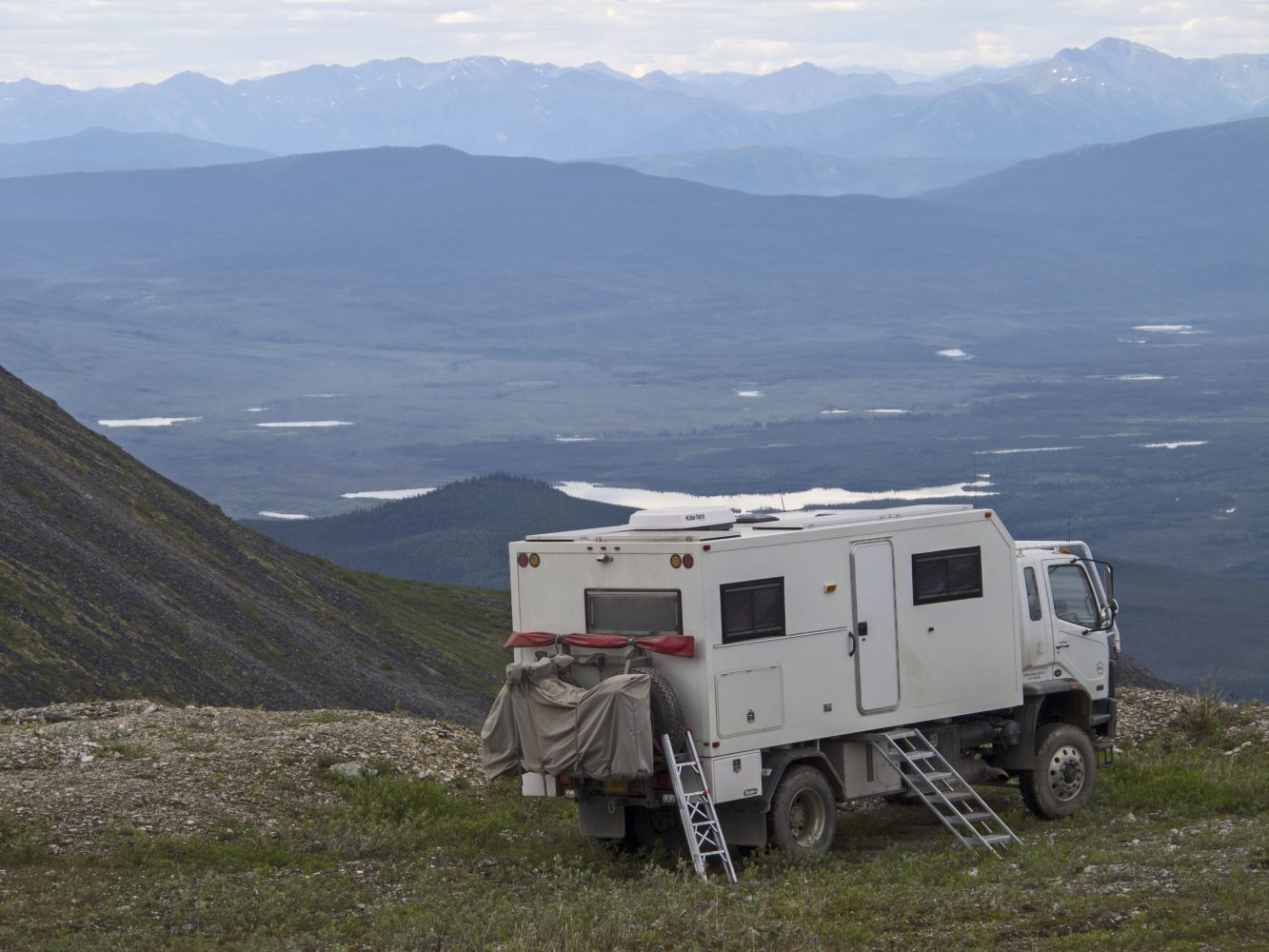As Expedition Portal has grown in size and coverage, we’ve seen more big expedition trucks built, reported on, and periodically sold through the Portal. But as with any overlanding vehicle, there are pros and cons, and compromises must be made.
Still, for a sizable minority of the Expo inmates, there’ll be a time when these big trucks are worth considering. A growing family, a need for more capacity to support real “expeditions,” or even just the realization that comfortable usually beats uncomfortable will make even devoted Tacoma or Wrangler owners admit the occasional advantage.
So what do you get, and what downsides do you put up with, if you have one of these big trail trucks? We’ve recruited Mike Hiscox to write three FVOTW episodes to tell what they’re like to drive and live out of. Mike’s early overlanding experience included 7 years with a big Unimog expedition camper, so he was eager for the opportunity to report on a recent run in a much newer Fuso FM conversion.
 It’s day three of the trip and I’m on a brief stretch of Oregon 293, transiting from camping down by the Prineville Reservoir to my new site by the John Day River at Clarno. The weather’s pretty nice, I’m well rested, and all is right with the world. The record-wet Oregon winter has made the scenery greener than I’ve ever seen it.
It’s day three of the trip and I’m on a brief stretch of Oregon 293, transiting from camping down by the Prineville Reservoir to my new site by the John Day River at Clarno. The weather’s pretty nice, I’m well rested, and all is right with the world. The record-wet Oregon winter has made the scenery greener than I’ve ever seen it.
Beautiful scenery through a huge windshield. Tough to beat. And I’m getting to gawk at it because I’m not having any trouble with the eleven tons of overland truck I’m captaining. Piloting a big trail truck apparently is like riding a bicycle.
This is a bit of a comparison test. In 2002, I took my 1977 custom Unimog camper through this same area on one of her first U.S. trips.
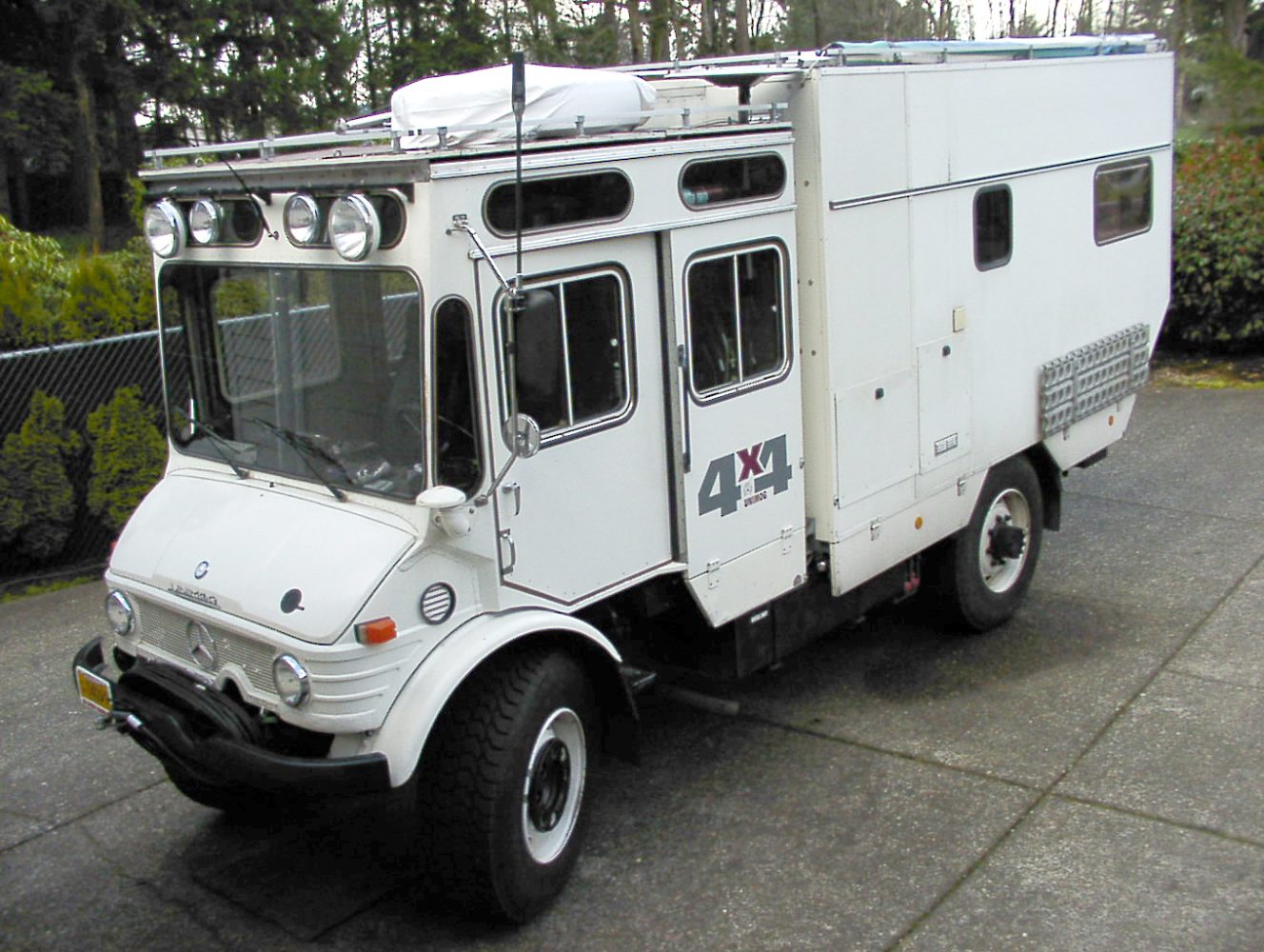
CamperMog was a splendid piece of equipment. Coach-built from a 416 Unimog traction head unit for the Netherlands Train Authority, the estimate was that the railroad had spent around a quarter-million dollars building her. She was later bought surplus and rebuilt into a Sahara expedition truck by one of the Netherlands’ more prominent overlanders. I felt fortunate to have been able to import her and kept her for 7 years.
CamperMog ended up being sold, but my big-camper interests remained strong. So when I was able to finagle the use of one of my favorite big rigs—one 30 years newer than my Mog—I was enthusiastic. And it didn’t take long to see that replicating one of my CamperMog trips in a modern truck that is conceptually and dimensionally very similar might make for a fun investigation. While I’ve scarcely changed in 30 years (scoff, chuckle), I was pretty sure the state of the art for big offroad camper haulers had.
Meet the star of the show.
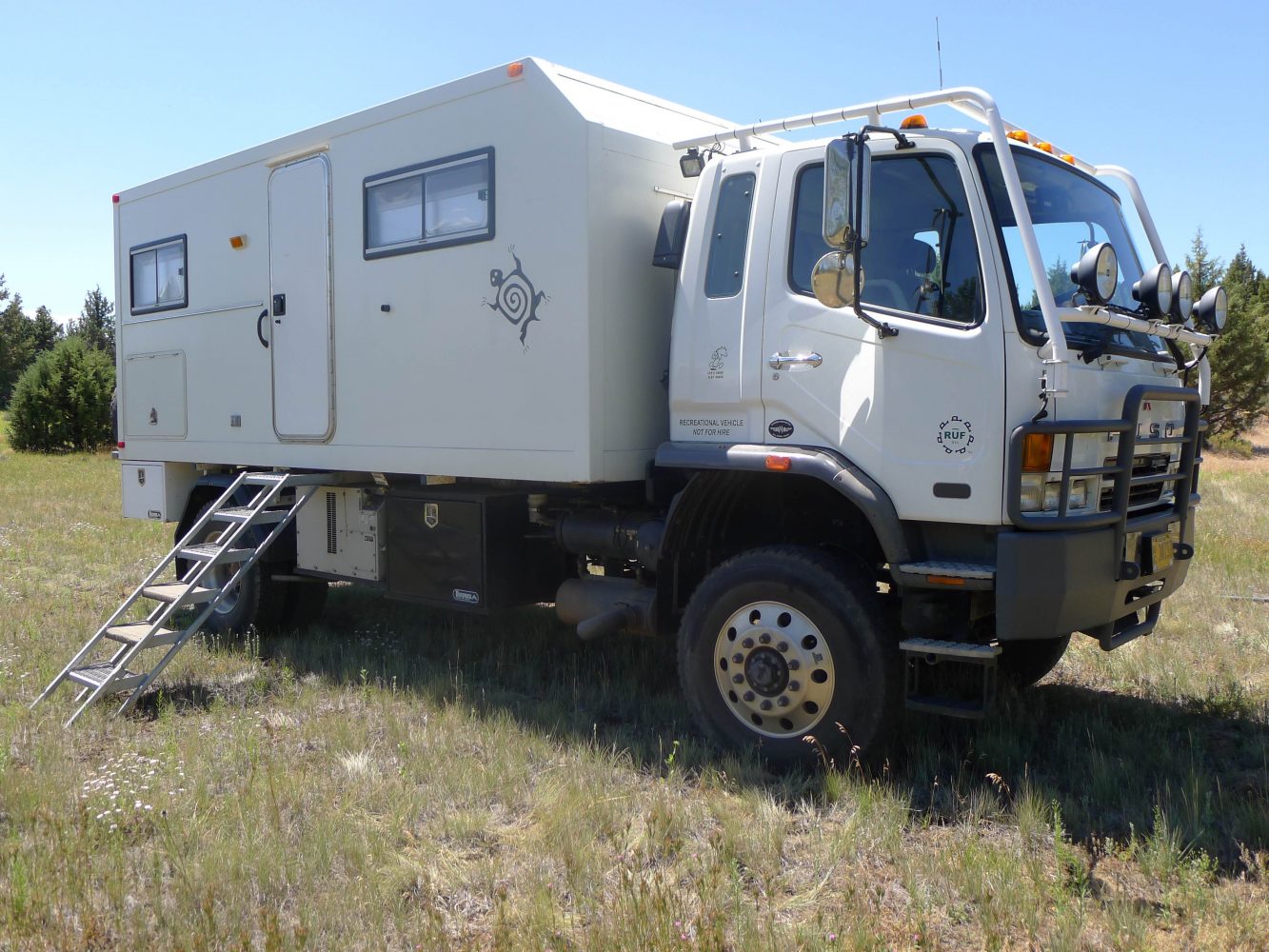 This is a 2007 Fuso FM260, owned by my good friend John Rhetts of Bend, Oregon. John and I go back a ways, and I go back with his camper even further, back to the point where the idea got thought up.
This is a 2007 Fuso FM260, owned by my good friend John Rhetts of Bend, Oregon. John and I go back a ways, and I go back with his camper even further, back to the point where the idea got thought up.
Because of Unimogging, I knew of the late Darrin Fink, a rancher outside Douglas, Wyoming, with wicked fabrication skills and a fleet of Unimogs. But while he recognized their advantages, he had no difficulty in seeing their weak points as overland trucks. And in particular, he wasn’t keen about starting out with any chassis that would be (in pre-U500 days) a minimum of 25 years old by the time he got it.
After completing a U1300-based camper, Darrin, through his company (Renaissance Universal Fabrication—RUF), built a Fuso FG camper which impressed the Mitsubishi-Fuso’s U.S. engineers enough to gain their cooperation and get a nice writeup in their company magazine.
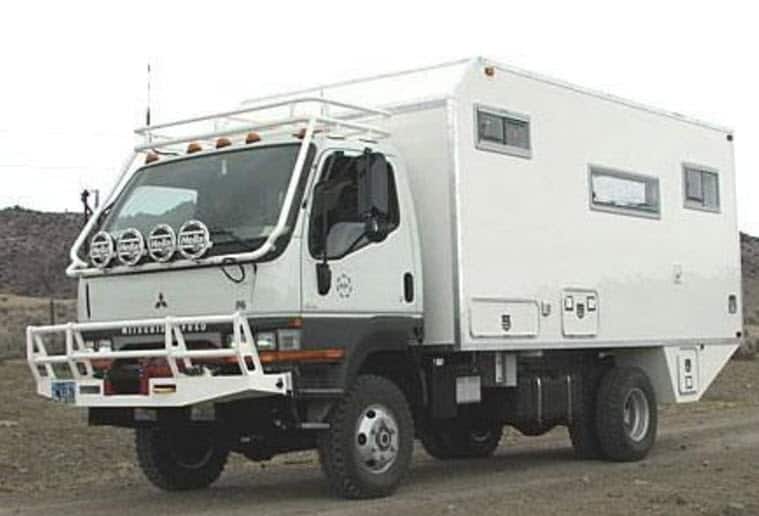
But Darrin didn’t like some of the changes made in the 2005 FG redesign, and was also looking for something that could handle more payload. His good relations with Fuso led him to stick with the brand and he decided that the Fuso FM260 would do the trick.
There was only one problem: it’s a two-wheel drive truck. So Darrin worked with the Fuso engineers, a mechanical engineering professor he hired as a consultant, and the engineers at Marmon-Herrington to develop two from-scratch 4WD setups for two FMs he bought, complete with dual-range transfer case and custom Dana axles.
 It all worked out fine and Darrin, having done the research to find what he believed to be the best possible material, had two sizable empty cabins built to his specifications and then added their systems and interiors. After owning different vehicles, including two EarthRoamer XV-LTs, John arranged to buy the second of Darrin’s converted Fusos.
It all worked out fine and Darrin, having done the research to find what he believed to be the best possible material, had two sizable empty cabins built to his specifications and then added their systems and interiors. After owning different vehicles, including two EarthRoamer XV-LTs, John arranged to buy the second of Darrin’s converted Fusos.
But enough about how we got here. Back to the road trip.
I’m sure John figured, “Well, if he could drive CamperMog all around without incident, he should be able to drive this.” And he was right. The Fuso’s similarities to CamperMog are amazing. The rig’s height and length are remarkably close. CamperMog had a true double cabin and a bit of a hood, so the Fuso has the smaller bumper-to-back-of-cab measurement. It offsets that, though, with a longer cabin, so that they end up about the same length. Both ride on similar size tires, both on 22.5-inch wheels.
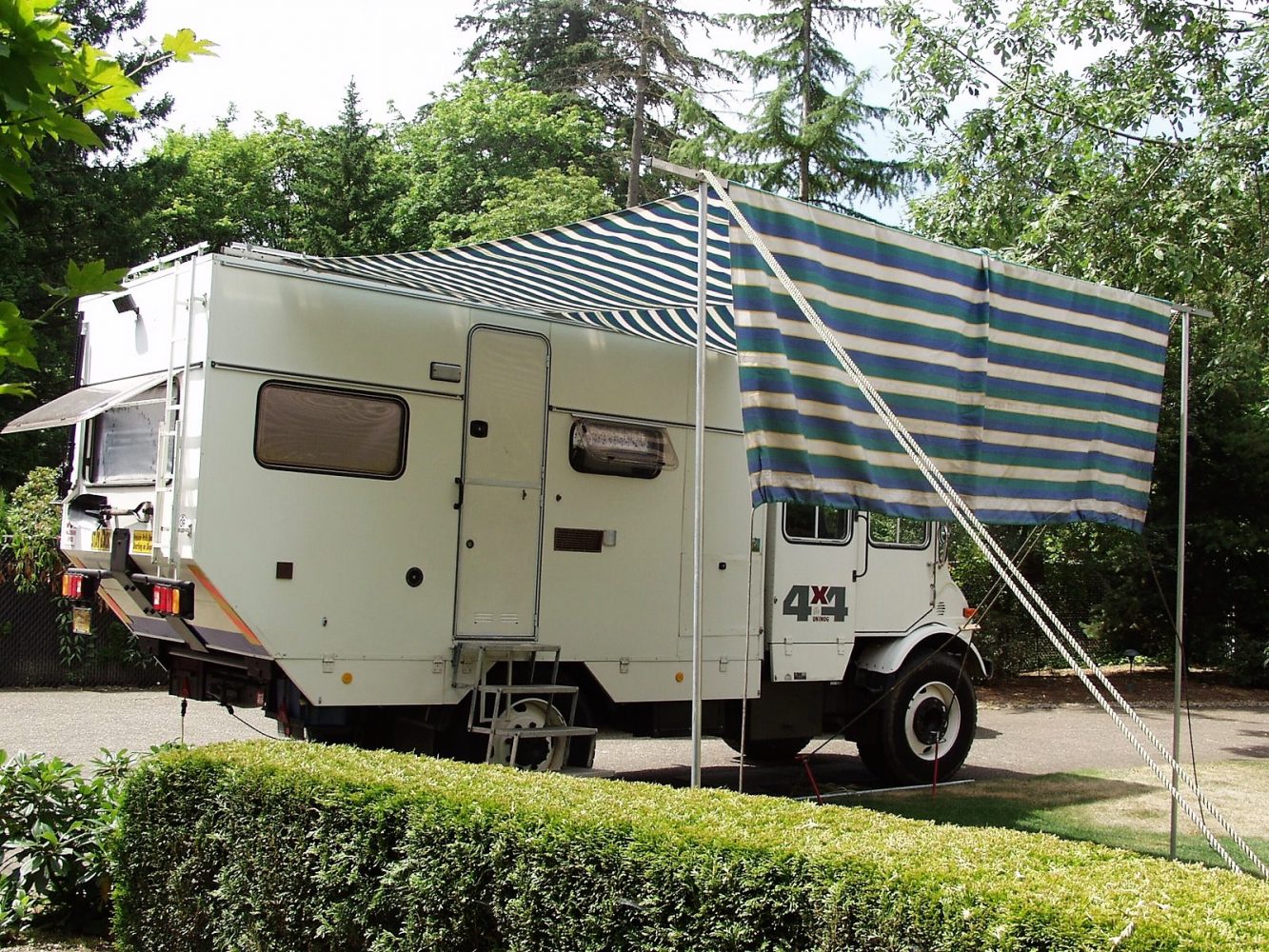
The cabs have about the same width, big mirrors, huge windshields, and excellent visibility. The Fuso has the easier cab entry, but once inside, things felt a lot the same. CamperMog, being created out of a 416 traction head, did have portal axles in the front, but the railroad was happy to exchange some ground clearance for increased reliability and payload by specing a “regular” axle and hubs for the rear axle.
So, yeah, kind of the same. Until you actually go somewhere.
It’s hard to overstate just how much the 30-year difference between the two trucks felt like every bit of 30 years. The principal problem was the engine. CamperMog’s 5.6-liter OM352 had a whopping 110-horsepower stock. I’d “tuned” the mechanical injection pump and tweaked the governor to pick up another 200 rpm, so my hot-rodded engine might have had 120 horsepower. Of course, that’s at sea level, and with a rough rule of thumb of losing 3 percent of the power for each thousand feet of altitude increase, things got even more dire climbing a mountain pass. The torque rating was 268 pound feet.
The FM has an intercooled turbocharged Mitsubishi 6M60 inline six that displaced 7.5 liters. Rated at 243 horsepower and 516 torque, it’s not exactly quick, but it was still a revelation. Even moving more weight, acceleration was much better and speeds were held on moderate grades that would have slowed my Mog. On long steep grades, however, the Fuso would eventually end up climbing the grade at the same 35 mph as CamperMog. It took longer to slow and got up to speed quicker, but if the grade was long enough, the Fuso performed pretty much like all the heavy trucks. The difference was that the Mog slowed even where most truck traffic didn’t, thus creating a bottleneck on busy highways. The Fuso slowed in the same places as all the over-the-road trucks, which meant that there were routinely passing lanes for faster traffic.
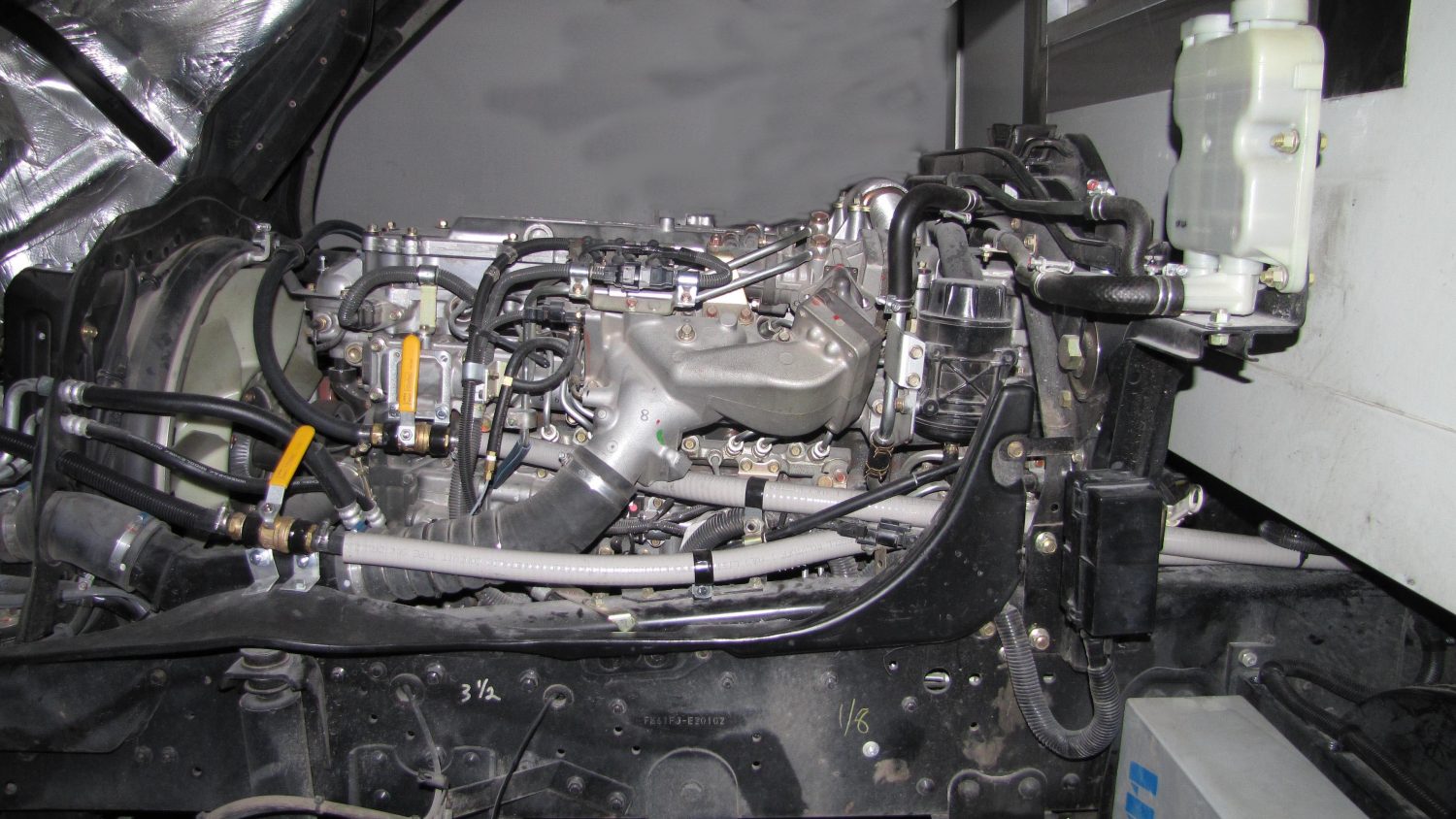 But it was the cruising speed on level ground where I saw the most practical difference. CamperMog had a top speed of 55 miles per hour. That was not a result of the engine’s meager horsepower; it was a result of the gearing. Even going downhill, the Mog couldn’t go any faster because it was up against the engine redline. From the factory, John’s FM was geared to go 79. Changes to the tires and driveline during the 4×4 conversion changed that to a Vmax of 85 mph, and the Fuso can, should one be willing to pay for the fuel, manage a sustained 75-mph cruise.
But it was the cruising speed on level ground where I saw the most practical difference. CamperMog had a top speed of 55 miles per hour. That was not a result of the engine’s meager horsepower; it was a result of the gearing. Even going downhill, the Mog couldn’t go any faster because it was up against the engine redline. From the factory, John’s FM was geared to go 79. Changes to the tires and driveline during the 4×4 conversion changed that to a Vmax of 85 mph, and the Fuso can, should one be willing to pay for the fuel, manage a sustained 75-mph cruise.
The bottom line is this: the modern Fuso did not routinely impede traffic; the older Unimog did. On a freeway or an empty two-lane, this is not a big deal, as faster vehicles can work around you easily enough. But on a two-lane with enough oncoming traffic to make passing impractical, a max-55 mph truck is a public nuisance and annoying to drive. I hit what passes for rush hour on US 97 heading back to Bend from Madras, and spent the time thinking about the joys of being in a truck that kept up with with traffic.
 Trucks this big don’t move without substantial amounts of fuel. I got 8 mpg in the Fuso with no freeway use and modest off-roading; John reports 7-8 during his ownership. However, the Fuso has dual 50 gallon tanks, so the truck has a range of better than 700. CamperMog, being outfitted to cross the Sahara, had three tanks combining for an impressive 141 gallons of fuel that it burned through at about 9-10 mpg. So the fuel consumption never caused operational problems for either truck.
Trucks this big don’t move without substantial amounts of fuel. I got 8 mpg in the Fuso with no freeway use and modest off-roading; John reports 7-8 during his ownership. However, the Fuso has dual 50 gallon tanks, so the truck has a range of better than 700. CamperMog, being outfitted to cross the Sahara, had three tanks combining for an impressive 141 gallons of fuel that it burned through at about 9-10 mpg. So the fuel consumption never caused operational problems for either truck.
Speaking of fuel, the Fuso does not require ultra-low sulfur diesel. New emission requirements requiring ULSD came into effect in 2007, but manufacturers were routinely allowed to use 2006 engines in the 2007 models. John’s truck, therefore, is the latest model year heavy truck that can travel throughout the world and stay registered in the United States. Because of this flexibility, many consider ‘07s to be particularly desirable. John’s truck also profits from not having a lot of emissions plumbing hung off the side rails. A lot of newer trucks in this weight range would be unsuitable for offroad travel because of the vulnerability of these components.

The five-speed Allison 2400 automatic transmission in the Fuso proved a big improvement over the four-speed (high-range) manual of my old Unimog. The addition of one extra gear combined with the extra power to give the Fuso much better roadability. When the grades ate into fifth gear, you could drop into fourth gear a bit below 50. In many cases, fourth was enough to pull a grade in the 40s that would have required the Mog to drop to 35 at best. The Allison was better in town as well, but the big difference showed on the grades.
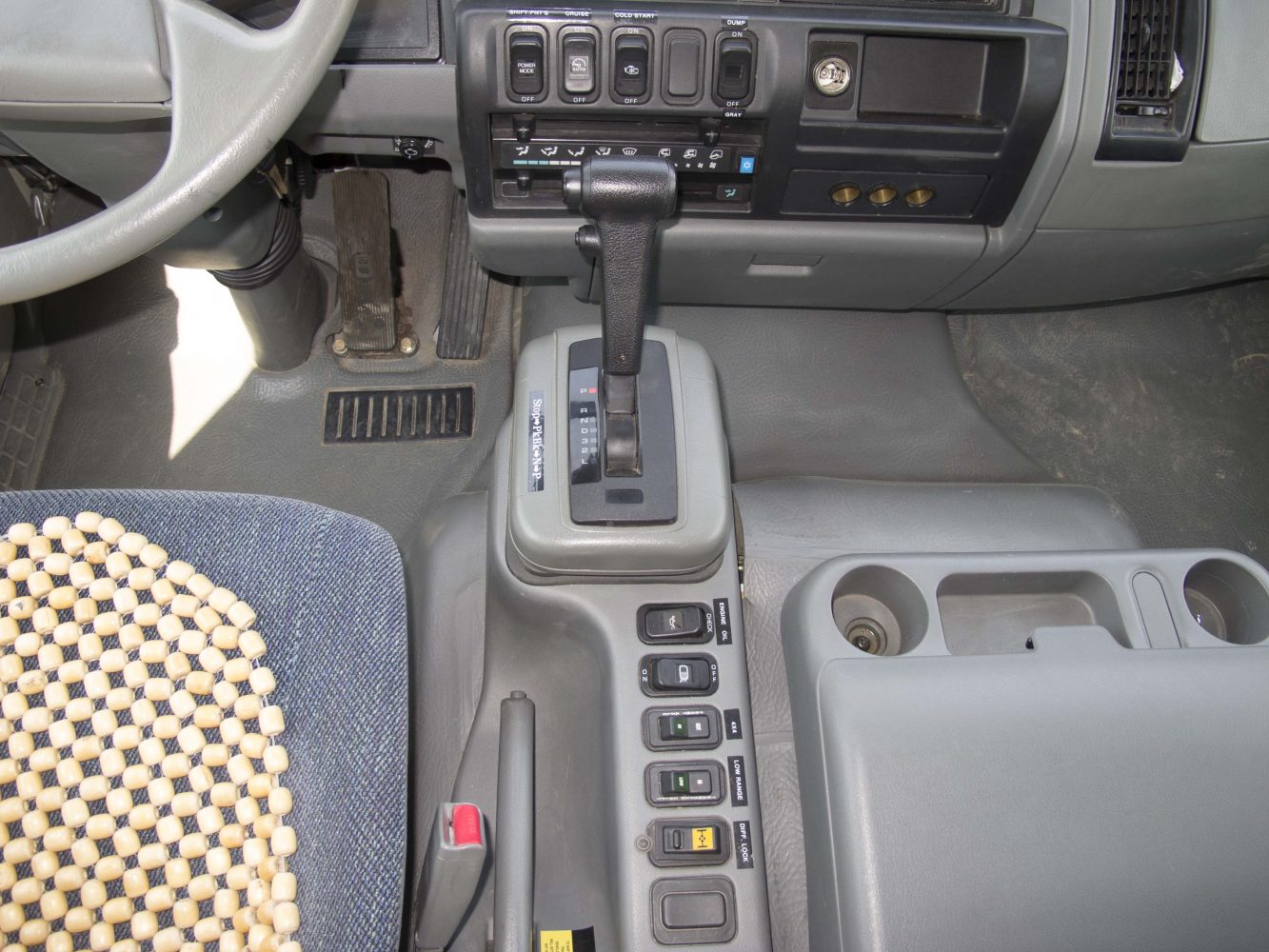 Off road, there’s not too much pro and con mechanically, save to point out what most will admit: driving an automatic on a trail gives you one less thing to worry about. It’s true that a Mog will have portal axles and the resultant massive ground clearance, but this rarely has a practical impact and the portals are a potential weak point on a Mog, especially one carrying a lot of weight. Both the Fuso and the Mog shift well in 4WD and the Mog’s low-range gearing made a low-speed trail the one place where it didn’t feel underpowered. Both trucks had low range and a locking rear differential, so both can pull themselves through difficult terrain.
Off road, there’s not too much pro and con mechanically, save to point out what most will admit: driving an automatic on a trail gives you one less thing to worry about. It’s true that a Mog will have portal axles and the resultant massive ground clearance, but this rarely has a practical impact and the portals are a potential weak point on a Mog, especially one carrying a lot of weight. Both the Fuso and the Mog shift well in 4WD and the Mog’s low-range gearing made a low-speed trail the one place where it didn’t feel underpowered. Both trucks had low range and a locking rear differential, so both can pull themselves through difficult terrain.
Like my Unimog, the Fuso also has a flexibly-mounted cabin, with the rear cabin subframe also on a pivot. But the Fuso frame is not designed to twist like a Mog’s, which means the Fuso cabin doesn’t move around as often, and never for quite as much distance. The rear cabin mount allows 15-20 degrees of flex, much reducing torque on the cabin and the cabinetry therein.
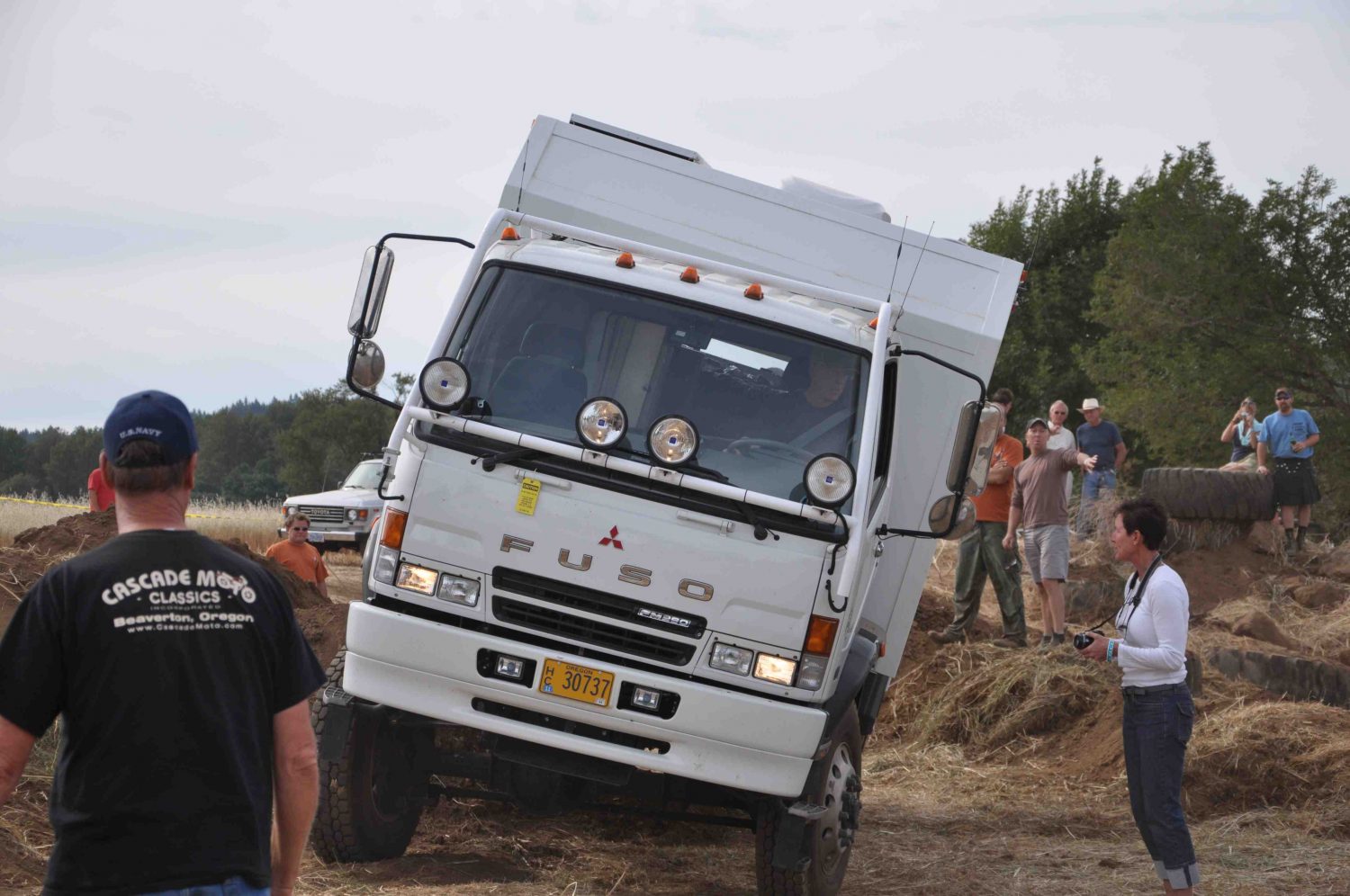 Overall, cabin movement never upset the Fuso’s handling, but sometimes effected the Mog’s.
Overall, cabin movement never upset the Fuso’s handling, but sometimes effected the Mog’s.
Cabover trucks have much tighter turning circles than a pickup-type chassis of similar length and, as a result, maneuvering is not an issue for either truck, even in tight off-road situations. Their power steering is light and never a strain, even when making a multi-point turn. The combination of easy steering effort and tight turning circle made the length of the vehicles no more than a minor issue. Even in tight campsites on the recent Oregon trip where it took a half-dozen back-and-forths to get the Fuso pointed the other direction, it wasn’t any real problem.
John’s FM conversions has factory air-assisted hydraulic brakes with new Bosch disks, and they work really well. Air and air-assisted brakes can sometimes have a bit of a light-switch, full-on/full-off, feel, but the Fuso’s brakes are easy to modulate. Plus the Fuso has antilock brakes, a comforting safety feature missing from older trucks.
The Fuso’s front rides on leaf springs and the axle runs right under the driver’s butt. The tires run a lot of psi. And everyone knows that cab-forward trucks have crappy rides. A guy would be lucky to make it through a day of such abuse, right?
 Nope, didn’t happen. The ride in the Fuso was totally okay. Good, even. I think it’s down to the weight and wheelbase. At 11 tons, John’s truck was carrying about 80 percent of its payload, and the long wheelbase was more than enough to avoid the porpoising that plagues shorter wheelbase trucks. Plus, the tires are big enough not to fall into every road gap. All in all, the negatives about the ride of a cabover didn’t apply here.
Nope, didn’t happen. The ride in the Fuso was totally okay. Good, even. I think it’s down to the weight and wheelbase. At 11 tons, John’s truck was carrying about 80 percent of its payload, and the long wheelbase was more than enough to avoid the porpoising that plagues shorter wheelbase trucks. Plus, the tires are big enough not to fall into every road gap. All in all, the negatives about the ride of a cabover didn’t apply here.
Off-pavement travel in a big trail truck is an interesting exercise. Obviously, you can’t go where the camper won’t fit. Most of these campers are about 11 feet tall, with many being taller. They’re generally 7 to 8 feet wide. And while both CamperMog and John’s Fuso are in the shorter half of the class, tight trails will still cause a good deal of backing and filling to make turns, even with a cabover’s good turning circle.
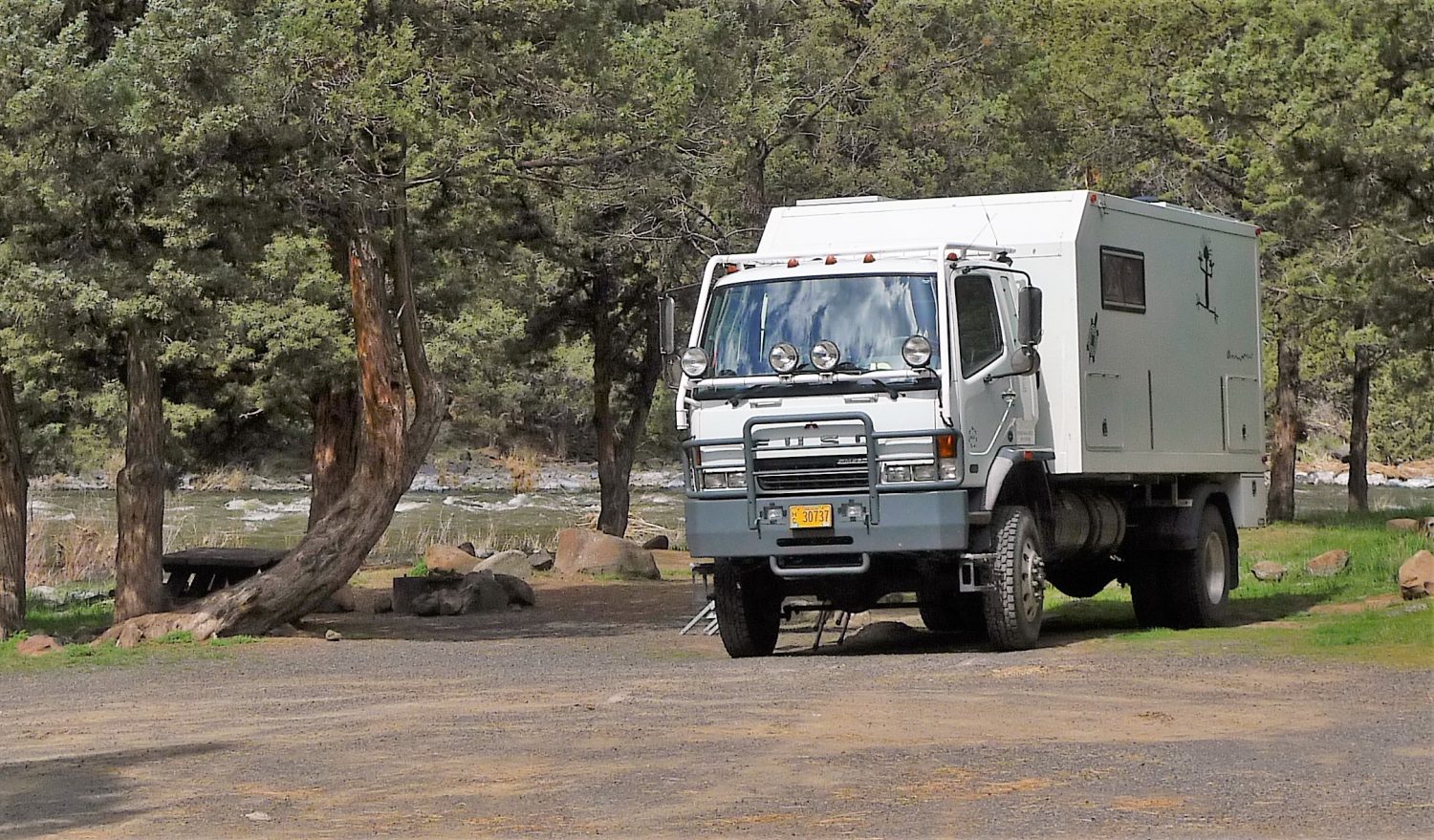 That said, if the trail has the room, these trucks are pretty competent. They’ve got lots of ground clearance, 40-plus-inch tires, and enough power and/or low gearing to make good progress. The big tire sections help in sand. Big rocks aren’t all that big to a truck this size and washboard doesn’t bounce 11 tons like it does a Tacoma. All in all, there are lots of open trails where the big expo campers would be a plausible and comfortable choice, and when simply handling an unpaved road, they are plush.
That said, if the trail has the room, these trucks are pretty competent. They’ve got lots of ground clearance, 40-plus-inch tires, and enough power and/or low gearing to make good progress. The big tire sections help in sand. Big rocks aren’t all that big to a truck this size and washboard doesn’t bounce 11 tons like it does a Tacoma. All in all, there are lots of open trails where the big expo campers would be a plausible and comfortable choice, and when simply handling an unpaved road, they are plush.
This is probably a good time to point out that a giant expo truck is only “giant” in the context of more commonplace expo trucks. My Mog and the Fuso are indeed big overlanders, but they are small and compact recreational vehicles. The L x W x H dimensions of the Fuso are, for example, almost identical to most of the Sprinter-based RVs sold as the “downsized” alternative for RVers, with the vast majority of on-pavement RVs being much larger.
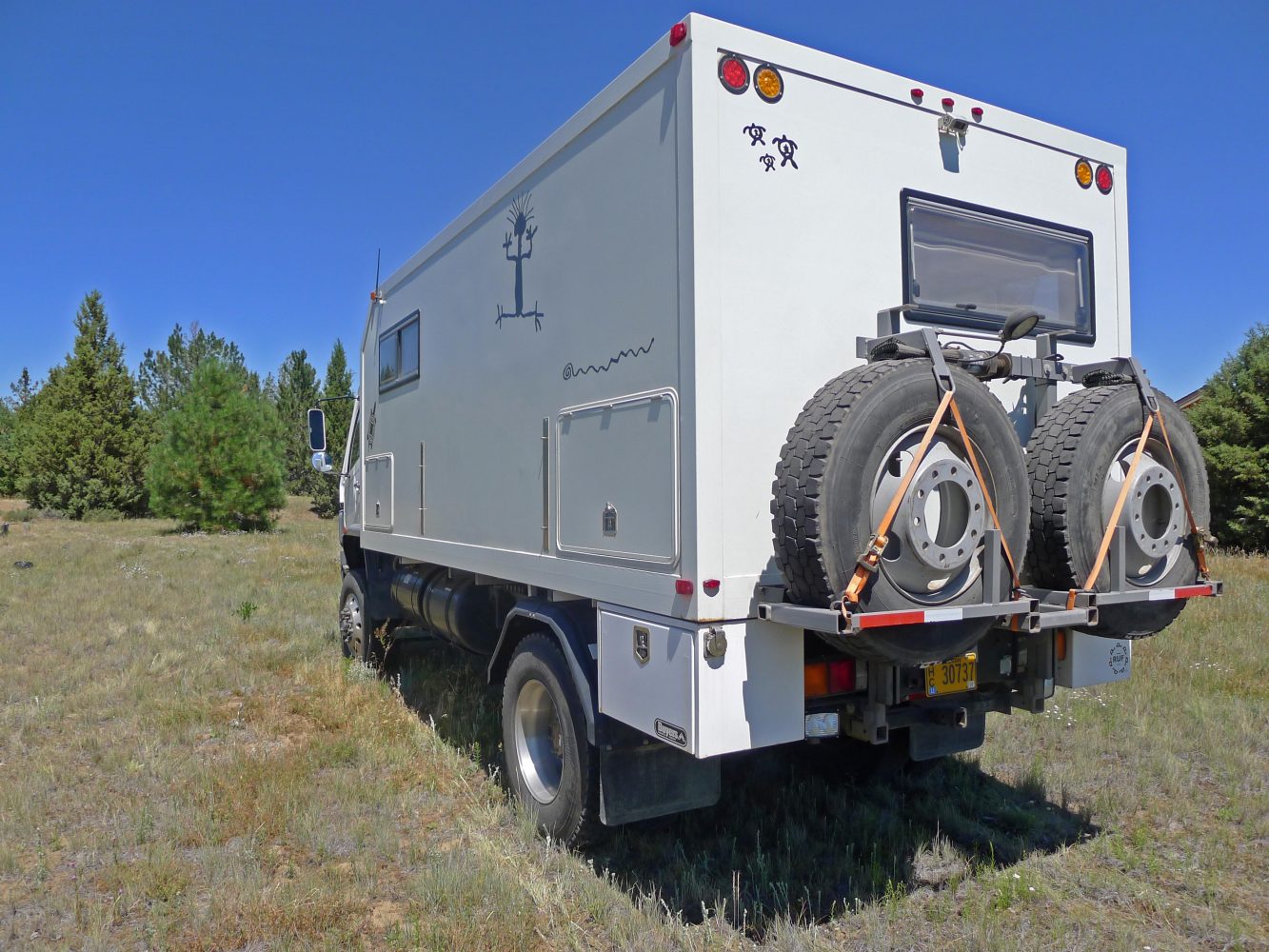
But it’s still hard to stop thinking “What if I do get stuck?” Recovering one of these trucks if something goes wrong isn’t going to be easy or cheap. But we’re not ‘wheelin here, we’re overlanding, and the big trucks can do this splendidly. Both CamperMog and the Fuso have been to some pretty remote sites, with CamperMog having multiple Sahara expeditions and the Fuso putting in a 3-month expedition to Alaska and the Yukon along with lots of desert camping.
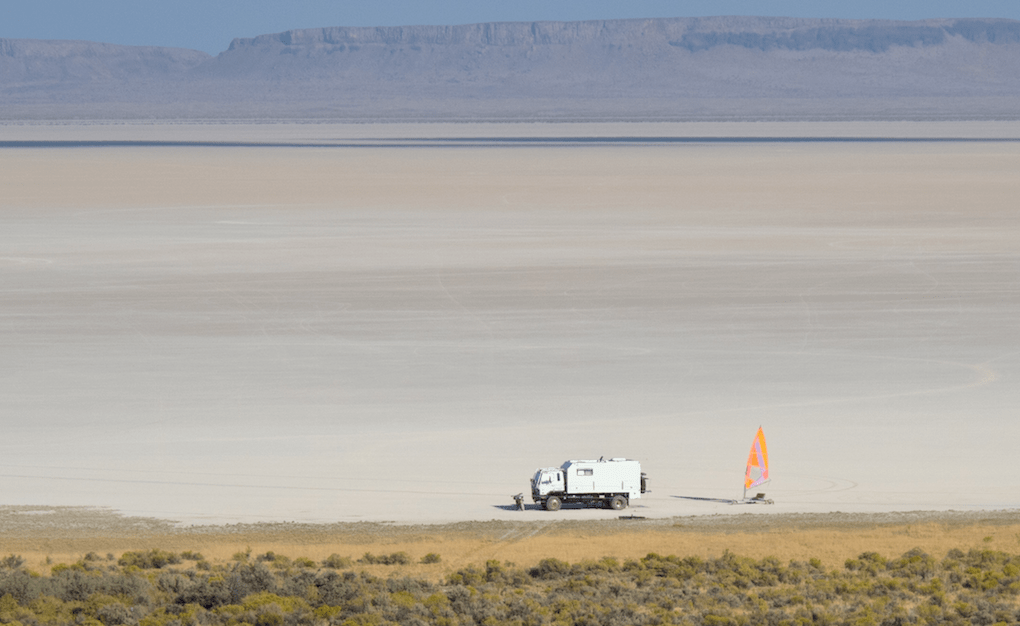
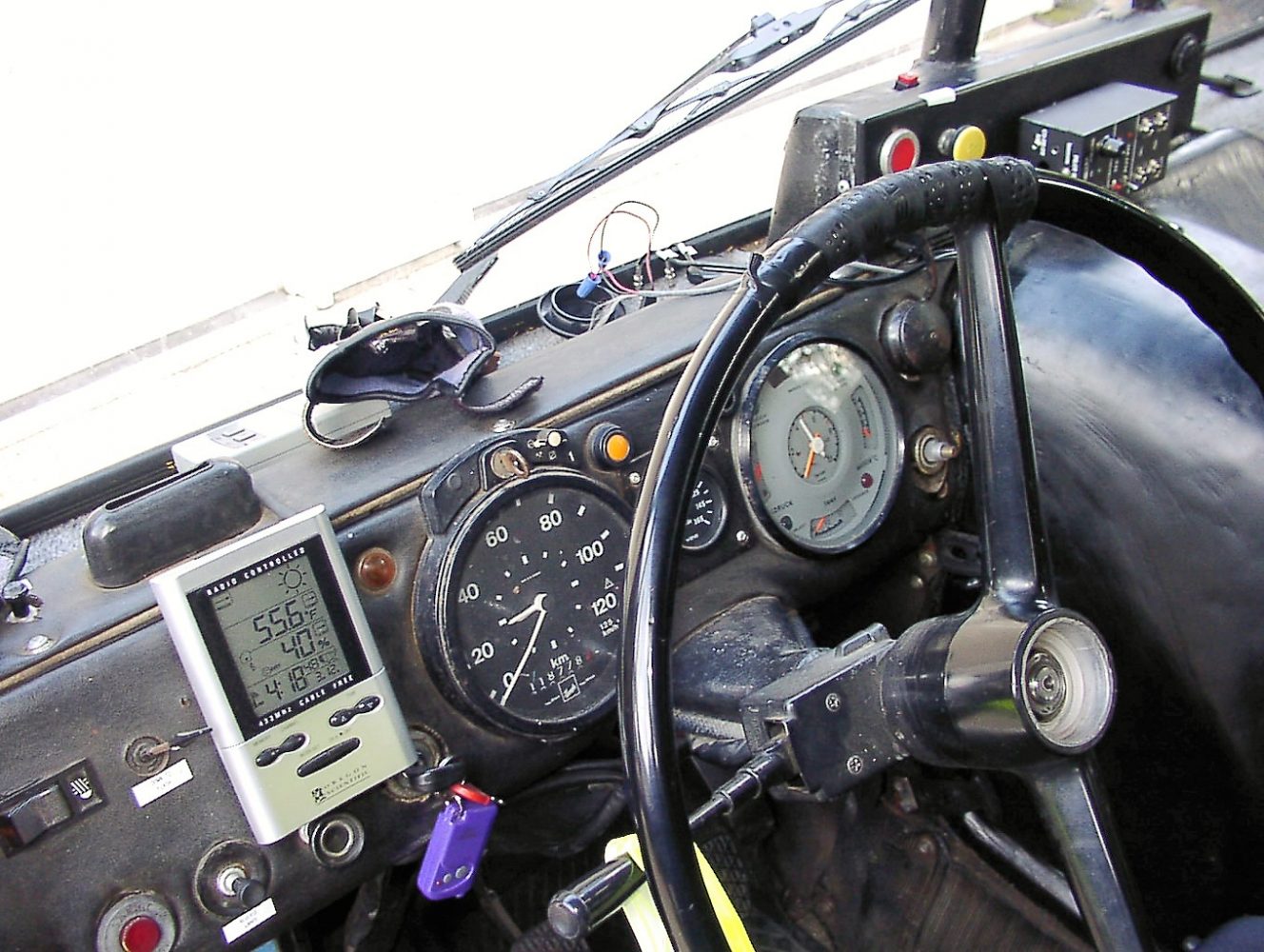
No one cared much about ergonomics in CamperMog’s day, but the Fuso cab received considerable attention. The cab suffers a bit from being a sea of gray plastic, but not much else is wrong. It has a tilt/telescoping steering wheel and multiple seat adjustments, so I had zero trouble getting a perfect driving position. The seats themselves don’t seem very special, but they were very comfortable for me, with excellent back support and just the right amount of roominess. Pedals are in the right place, instruments are clear, even the radio is decently located. The grab handles to get in and out are in the right spots and the steps are secure (though the height of the lowest step is still substantial). You even get storage bins and cupholders.
 CamperMog was problematically loud inside, and she was one of the quieter Mogs around. The Fuso isn’t exactly quiet, but it’s quieter than I’d expected and much more peaceful than an old Mog. Wind, tire, and engine noise all combined into a generic noise that I didn’t find objectionable or fatiguing.
CamperMog was problematically loud inside, and she was one of the quieter Mogs around. The Fuso isn’t exactly quiet, but it’s quieter than I’d expected and much more peaceful than an old Mog. Wind, tire, and engine noise all combined into a generic noise that I didn’t find objectionable or fatiguing.
Remember in the last episode where I focused on what a huge improvement the Fuso engine was over my old Mog? Here’s the second biggest wonderful thing brought about by 30 years of progress: the Fuso has air conditioning.
Before you write me off as a total wussie, consider the amount of glass in CamperMog’s cab. It is enormous. Acres of glass. And while CamperMog was an exceptional case, most big trail trucks will have large windshield and considerable side window glass. On a sunny day, all that glass is a wizard at transmitting heat into the cabin. The Fuso combined a great view out with fully adequate climate control.
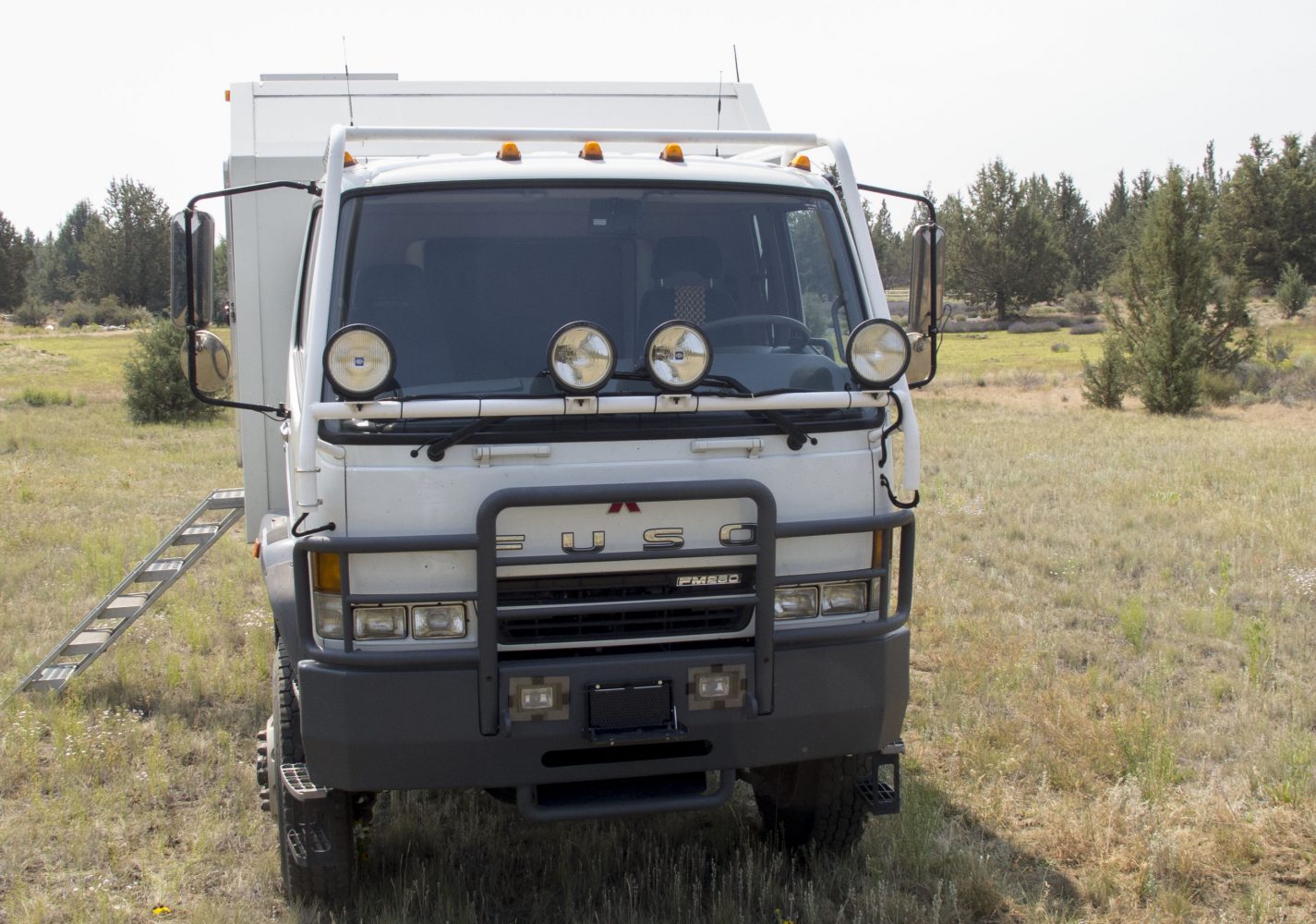 All in all, my Central Oregon expedition trip was great. The area never looked more scenic and John’s Fuso was a revelation. I really enjoyed driving it, and I was pretty amazed at just how good it was. But it wasn’t much of a challenge to drive it around, either on- or off-road.
All in all, my Central Oregon expedition trip was great. The area never looked more scenic and John’s Fuso was a revelation. I really enjoyed driving it, and I was pretty amazed at just how good it was. But it wasn’t much of a challenge to drive it around, either on- or off-road.
The Fuso—representative of the modern U.S.-legal diesel chassis—didn’t actually add much to the trip’s adventure quotient. It was, instead, the perfect tool to use to facilitate an adventure. On the other hand, CamperMog, in common with most of the 25-plus-year-old expedition trucks available to import, occasionally contributed a good deal of adventure on its own.
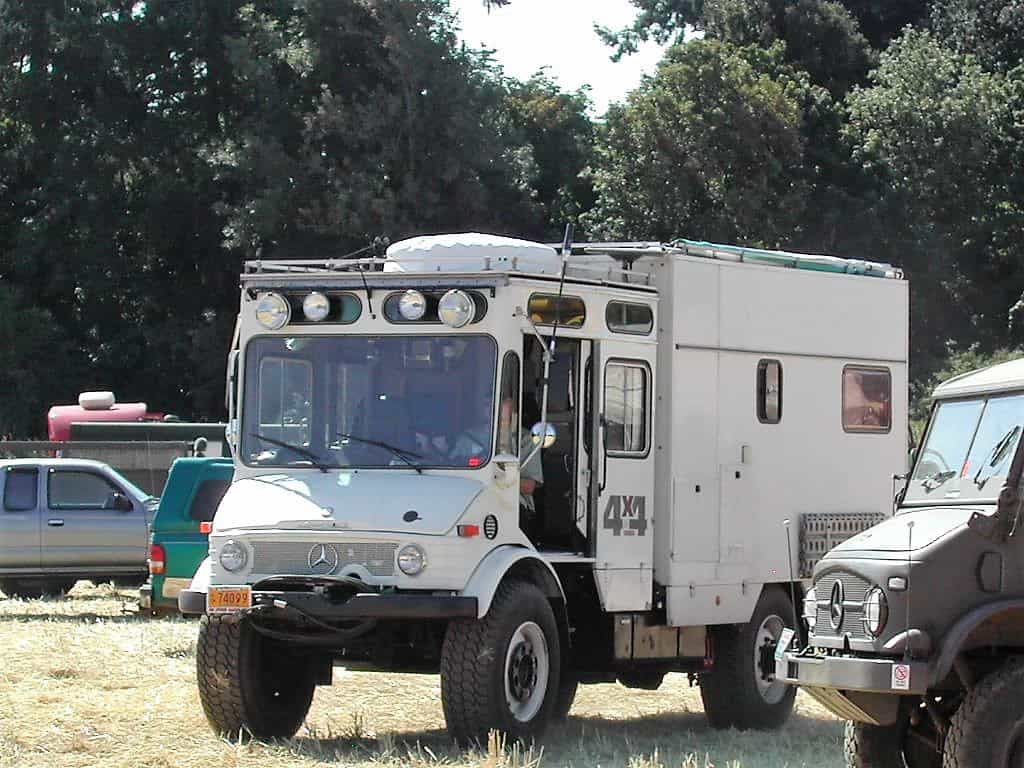 Which is preferable? For me, the Fuso is the slam dunk choice. I now very much like the idea of having a vehicle hauling my living quarters that is powerful, reliable, comfortable, and easy to drive. I’m not looking to work hard getting from Point A to Point B, and John’s truck is cake to drive. It’s pretty macho to be sitting up high looking out the big windshield piloting 11 tons down the road, but the degree of difficulty is negligible. If I set off on a transcontinental trip in the Fuso, you could expect a postcard from Florida with nothing to report about the vehicle.
Which is preferable? For me, the Fuso is the slam dunk choice. I now very much like the idea of having a vehicle hauling my living quarters that is powerful, reliable, comfortable, and easy to drive. I’m not looking to work hard getting from Point A to Point B, and John’s truck is cake to drive. It’s pretty macho to be sitting up high looking out the big windshield piloting 11 tons down the road, but the degree of difficulty is negligible. If I set off on a transcontinental trip in the Fuso, you could expect a postcard from Florida with nothing to report about the vehicle.
The same trip in CamperMog would have been worth a certificate of accomplishment at a minimum. The truck itself would have created things to deal with. There’d have been traffic issues, mechanical issues, comfort issues. But it’s not all bad; many will argue that overcoming assorted adversities is what turns a trip into an adventure. It might be fair to conclude that the old trucks are, at times, adventure-causing, while the new trucks are merely adventure-enabling.
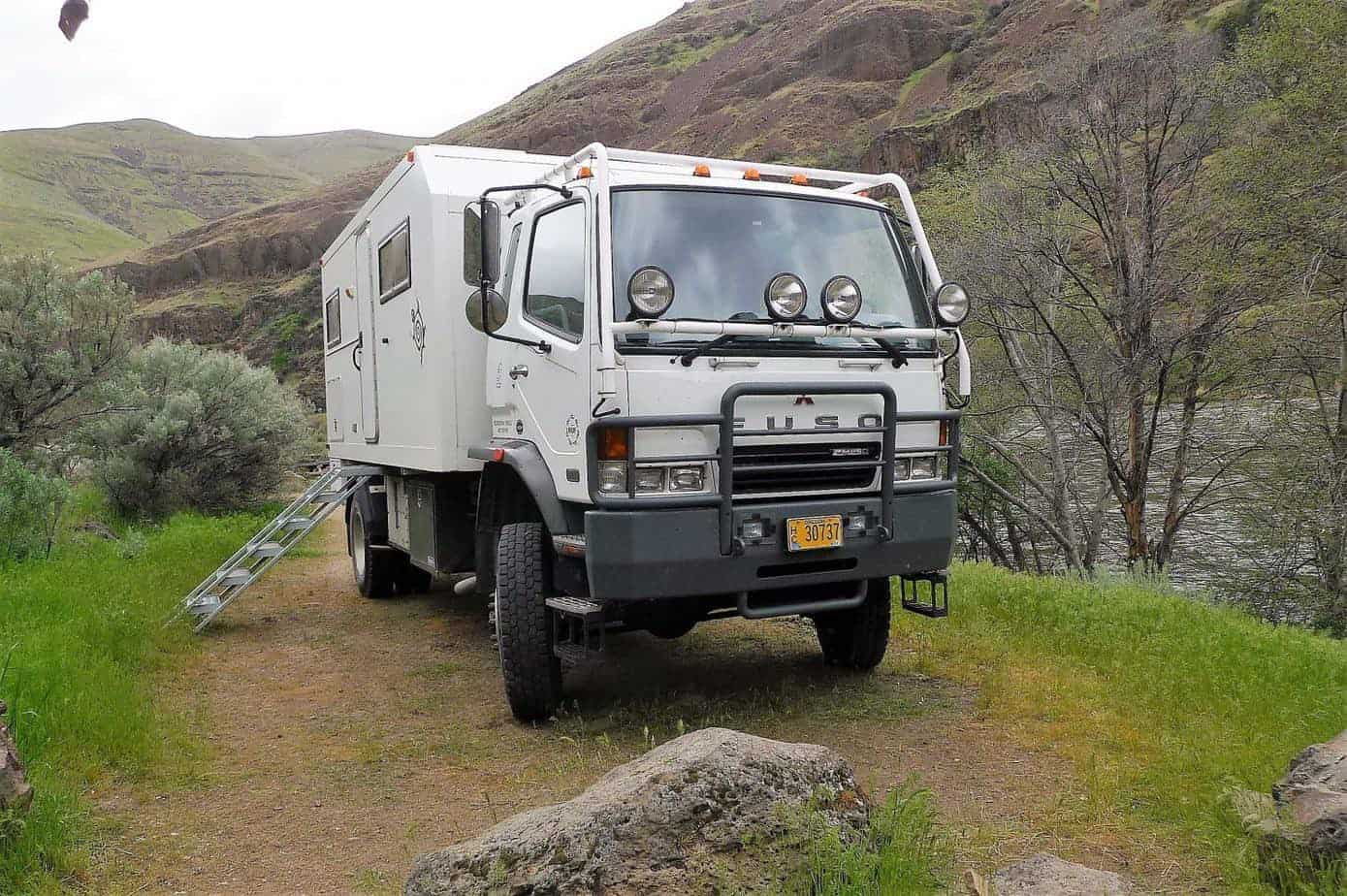 Is this sort of analysis relevant? After all, the cost of one of these more modern big expedition trucks is likely to be anywhere from three to five times the cost of the equivalent truck that’s 25 years or older. Sadly, obtaining the power, reliability, and comfort of the modern heavy expo truck will be too expensive for many. So you might want the older truck just because it’s affordable and the modern alternatives are not. Or you might want it because it’s special and contributes to the adventure.
Is this sort of analysis relevant? After all, the cost of one of these more modern big expedition trucks is likely to be anywhere from three to five times the cost of the equivalent truck that’s 25 years or older. Sadly, obtaining the power, reliability, and comfort of the modern heavy expo truck will be too expensive for many. So you might want the older truck just because it’s affordable and the modern alternatives are not. Or you might want it because it’s special and contributes to the adventure.
Either way, remember that with an older truck you’ll most likely get the adventure whether you want it or not. An old heavy truck is not likely what you are used to, and while there are occasional old expo trucks that don’t fit my stereotype, most do, and so you need to visualize a day of driving in a noisy cab with no air conditioning in one of the slowest vehicles on the road before deciding if it will suit you.
“I can take hardship. I can sleep on the cold floor anytime. I can also sleep on a feather bed.” Ngozi Okonjo-Iweala, an important African economist, said that. I’d have said that, too, were I equally clever.
I’ve got a lot of “been there, done that” in my camping history, and have ticked the boxes for most every gear configuration around. And, if I was time-machined (way) back to the days of my Holubar Royalight tent and Ensolite mat, I suspect I’d still cope.
That doesn’t mean I’d want to, though. One joy of having tried all the options is being able to glom onto comfortable ways of doing things without feeling second-rate for not having suffered adequately. While there’s accomplishment in fighting off the midges and not face-planting during the 2:00 a.m. trip to the potty tent, once you’ve mastered this stuff, I believe that you’re entitled to move on uptown.
 And move on I have. On the Central Oregon trek described previously, John Rhetts’s RUF-built 2007 4WD Fuso FM provided very solid accommodations, incredible amounts of storage, and systems not much inferior to home sweet home. Indeed, with the Tiny House movement going strong, I drove around plotting how I could demount the cabin and profitably rent it out in several pricey metropolitan areas.
And move on I have. On the Central Oregon trek described previously, John Rhetts’s RUF-built 2007 4WD Fuso FM provided very solid accommodations, incredible amounts of storage, and systems not much inferior to home sweet home. Indeed, with the Tiny House movement going strong, I drove around plotting how I could demount the cabin and profitably rent it out in several pricey metropolitan areas.
That’d scarcely be highest and best use, though. That would be more like the 3-month trip John took to Alaska and the Yukon in the truck. The adventure was a great success, free of incident and hardship, even when traveling through 18 inches of snow on the North Canol Road on July 8th. It was the sort of epic trip that simply could not be pulled off as well in a smaller, less comprehensively equipped overland truck.
 In the first two parts of this report, I constantly contrasted John’s modern Fuso with my older Unimog camper, using CamperMog to exemplify the sort of big camper that can be imported into the U.S. under the 25-year exemption. I reported that the “while moving” differences between the trucks were huge, with the advantages of the newer truck being really obvious. On the other hand, I‘ve learned that the “while parked” differences are minimal. The Fuso cabin is a little bigger and a little nicer, but the “30-years newer” advantage isn’t nearly as great for the Fuso’s systems and living quarters as for the trucks’ mechanicals. John’s Fuso uses a different toilet setup, and has substantial solar that CamperMog didn’t have. But otherwise the Fuso and Mog (and most other big expedition campers) have a lot in common and there’s probably not much need to comment on my old Mog’s setup going forward, since the advantages are quite similar.
In the first two parts of this report, I constantly contrasted John’s modern Fuso with my older Unimog camper, using CamperMog to exemplify the sort of big camper that can be imported into the U.S. under the 25-year exemption. I reported that the “while moving” differences between the trucks were huge, with the advantages of the newer truck being really obvious. On the other hand, I‘ve learned that the “while parked” differences are minimal. The Fuso cabin is a little bigger and a little nicer, but the “30-years newer” advantage isn’t nearly as great for the Fuso’s systems and living quarters as for the trucks’ mechanicals. John’s Fuso uses a different toilet setup, and has substantial solar that CamperMog didn’t have. But otherwise the Fuso and Mog (and most other big expedition campers) have a lot in common and there’s probably not much need to comment on my old Mog’s setup going forward, since the advantages are quite similar.
The Fuso’s cabin is a robust place. It’s over 16 feet long, a bit less than 8 feet wide and about 7 feet tall on the outside. Builder Darrin Fink had his two RUF FM cabins built by Martin-Marietta Corporation out of Transonite® composite panels. Transonite is functionally similar to a variety of composite panels in having thin outer panels of a material (usually fiberglass in the camper-building world) separated by a thicker middle layer, generally of foam or honeycomb. And as you’d guess, the Transonite panels share the usual composite panel advantages of being lightweight, repairable, and low on sound and thermal transfer.
 The cabin uses Dometic/Seitz-style windows that combine plastic framing with dual pane acrylic plastic glazing. These windows are a common selection in expedition cabins, offering low heat transfer, integrated shade/screen cassettes and pretty secure latching. The two main drawbacks are that the scratches the window plastic picks up need to be periodically polished out and the screens aren’t teensy-bug-proof, but they are generally a decent choice for less money than more elegant offerings. The Fuso has three large slider windows and a big awning-style window by the bed.
The cabin uses Dometic/Seitz-style windows that combine plastic framing with dual pane acrylic plastic glazing. These windows are a common selection in expedition cabins, offering low heat transfer, integrated shade/screen cassettes and pretty secure latching. The two main drawbacks are that the scratches the window plastic picks up need to be periodically polished out and the screens aren’t teensy-bug-proof, but they are generally a decent choice for less money than more elegant offerings. The Fuso has three large slider windows and a big awning-style window by the bed.
The entry door seems just the right size; at 26 inches wide and 66 inches high, it’s easy to get through without wasting wall space. The retractable folding steps are easy to store and a solid way to get up to the cabin, which, given the Fuso’s big tires and the need for a flexibly-mounted subframe, is a ways up in the air: it’s 6 steps and 55 inches up to the cabin floor.
 Several windows are big enough to get out of in an emergency that blocked the door, but expedition vehicles are traditionally also supposed to have an emergency connection between the cab and cabin. This is so you can drive off in the truck without going outside when bandits or bears are threatening your safety. I’ve never had occasion to do that, but there’ve been about a thousand times I wanted something left in the cab and have enjoyed having good passthroughs to fetch it without going outside. John’s Fuso FM has a rather nice opening into the cabin that is plenty big to get through without much contortion.
Several windows are big enough to get out of in an emergency that blocked the door, but expedition vehicles are traditionally also supposed to have an emergency connection between the cab and cabin. This is so you can drive off in the truck without going outside when bandits or bears are threatening your safety. I’ve never had occasion to do that, but there’ve been about a thousand times I wanted something left in the cab and have enjoyed having good passthroughs to fetch it without going outside. John’s Fuso FM has a rather nice opening into the cabin that is plenty big to get through without much contortion.
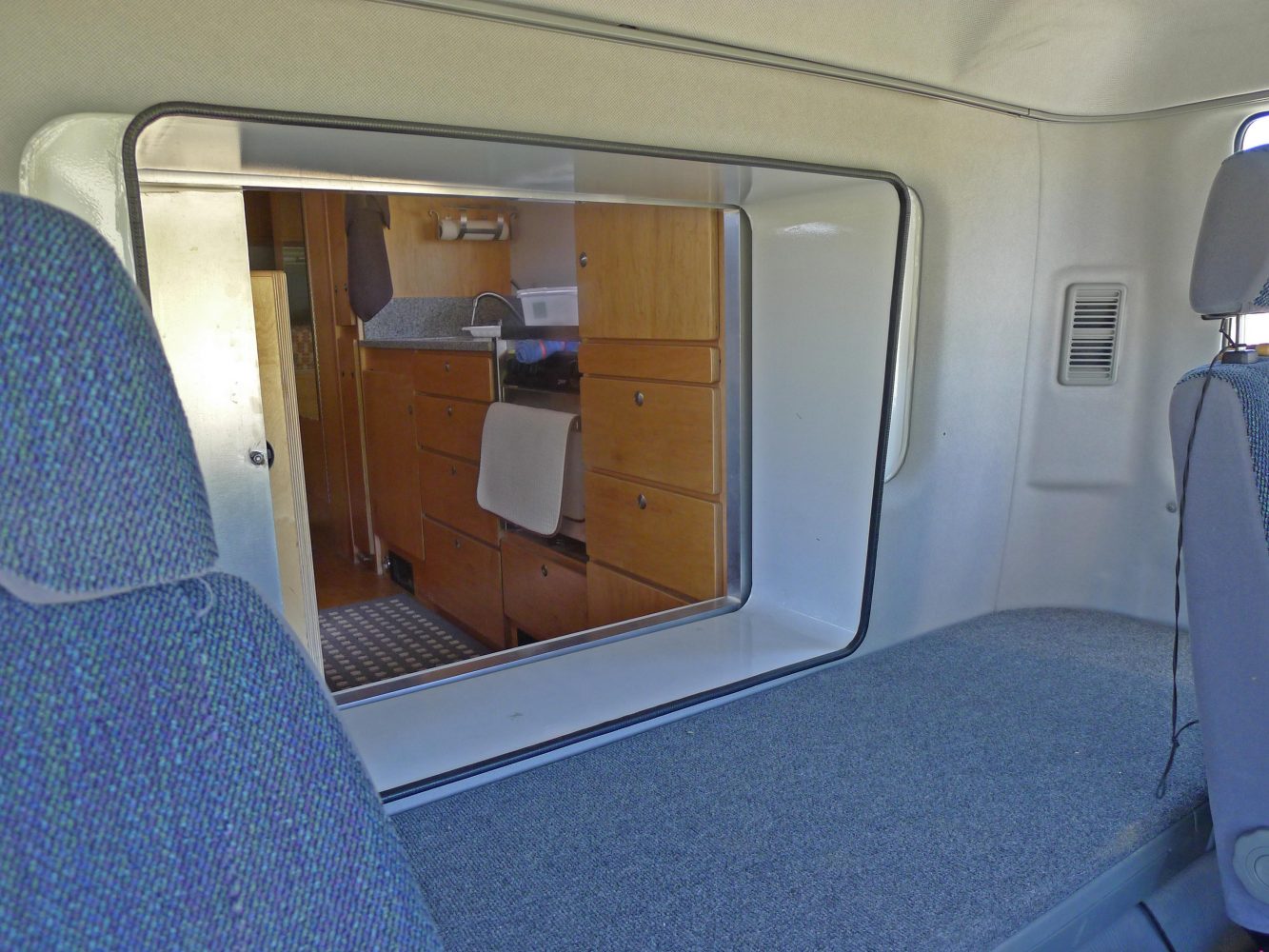 On a ten-point scale where cooking with good home facilities is a ten and the titanium pot on the Jetboil stove is a one, figure that the Fuso ranks about a 9.6. The NovaKool RFU9000 refrigerator, with separate freezer compartment, is 9.1 cubic feet. That’s over four times as much capacity as the relatively large 60-liter chest fridge in my Sprinter, and a good example of why you can go to remote locations for months with only occasional food runs. And to add to the capability, the truck also carries an Engel 35-liter chest unit under the forward bench seat that’s available as a dedicated additional freezer or fridge.
On a ten-point scale where cooking with good home facilities is a ten and the titanium pot on the Jetboil stove is a one, figure that the Fuso ranks about a 9.6. The NovaKool RFU9000 refrigerator, with separate freezer compartment, is 9.1 cubic feet. That’s over four times as much capacity as the relatively large 60-liter chest fridge in my Sprinter, and a good example of why you can go to remote locations for months with only occasional food runs. And to add to the capability, the truck also carries an Engel 35-liter chest unit under the forward bench seat that’s available as a dedicated additional freezer or fridge.
 Cooking is no issue either, with a wide, deep stainless sink, plenty of open solid-surface countertop, and a three-burner Force 10 propane cooktop above its oven. There’s enough elbow room to undertake any meal, along with enough space and hot water to clean up after it. And with the space heating—quiet and nicely ducted around the cabin—covered by an Espar Hydronic D5 diesel heater drawing fuel from the truck’s 100-gallon fuel supply, the 20-pound propane supply provides enough stove fuel for a year’s worth of cooking.
Cooking is no issue either, with a wide, deep stainless sink, plenty of open solid-surface countertop, and a three-burner Force 10 propane cooktop above its oven. There’s enough elbow room to undertake any meal, along with enough space and hot water to clean up after it. And with the space heating—quiet and nicely ducted around the cabin—covered by an Espar Hydronic D5 diesel heater drawing fuel from the truck’s 100-gallon fuel supply, the 20-pound propane supply provides enough stove fuel for a year’s worth of cooking.
 The meals get served on a clever folding table that opens up to seat four, but then swivels and folds out of the way to provide a nice lounging area for two to sprawl. The high-grade vinyl-covered cushions are nicely padded, resulting in about as much comfort as you would expect on your living room sofa. There’s also music or a ballgame if you want it available from a satellite radio.
The meals get served on a clever folding table that opens up to seat four, but then swivels and folds out of the way to provide a nice lounging area for two to sprawl. The high-grade vinyl-covered cushions are nicely padded, resulting in about as much comfort as you would expect on your living room sofa. There’s also music or a ballgame if you want it available from a satellite radio.
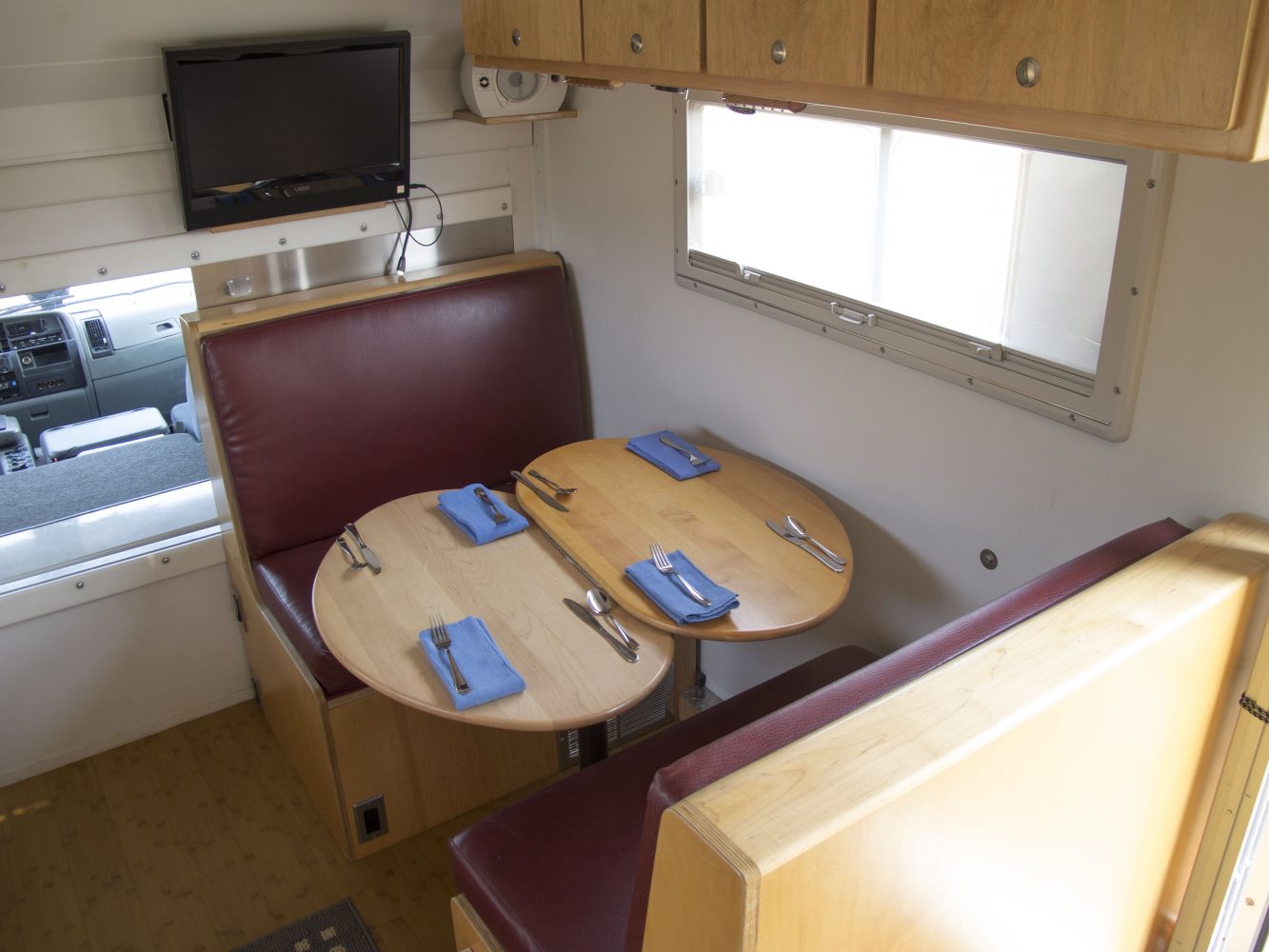 Plugs, both AC and DC, are well-situated throughout the cabin. Available power is considerable, with three AGM batteries, each having over 200 amp-hours capacity. Recharging those batteries can be done through a shorepower connection, by the 4KW onboard diesel generator or, most commonly, with nearly a kilowatt of solar power supplied by four panels on the roof. There’s comprehensive instrumentation which, in the case of my own boondocking, showed that the solar wattage collected stayed well in front of my use.
Plugs, both AC and DC, are well-situated throughout the cabin. Available power is considerable, with three AGM batteries, each having over 200 amp-hours capacity. Recharging those batteries can be done through a shorepower connection, by the 4KW onboard diesel generator or, most commonly, with nearly a kilowatt of solar power supplied by four panels on the roof. There’s comprehensive instrumentation which, in the case of my own boondocking, showed that the solar wattage collected stayed well in front of my use.
 The cabin has an enclosed bath with shower, mirrors and soap/shampoo racks—all the comforts of home. Well, except for the fact that there’s a toilet sitting in part of the shower pan. This is John’s Nature’s Head composting toilet. Many, including John, are sold on the composting toilet advantages, and John started an extensive thread on the ExPo forums discussing them.
The cabin has an enclosed bath with shower, mirrors and soap/shampoo racks—all the comforts of home. Well, except for the fact that there’s a toilet sitting in part of the shower pan. This is John’s Nature’s Head composting toilet. Many, including John, are sold on the composting toilet advantages, and John started an extensive thread on the ExPo forums discussing them.
(http://forum.expeditionportal.com/threads/57461)
On my trip, the toilet was wizard, with no stink and no need to futz with it. It can be (and usually is) lifted out and set in the aisleway to provide plenty of space for showering. And that showering is pretty posh, given the Espar Hydronic can supply unlimited hot water up to the capacity of the tanks (105 gallons fresh and 33 gallons gray).
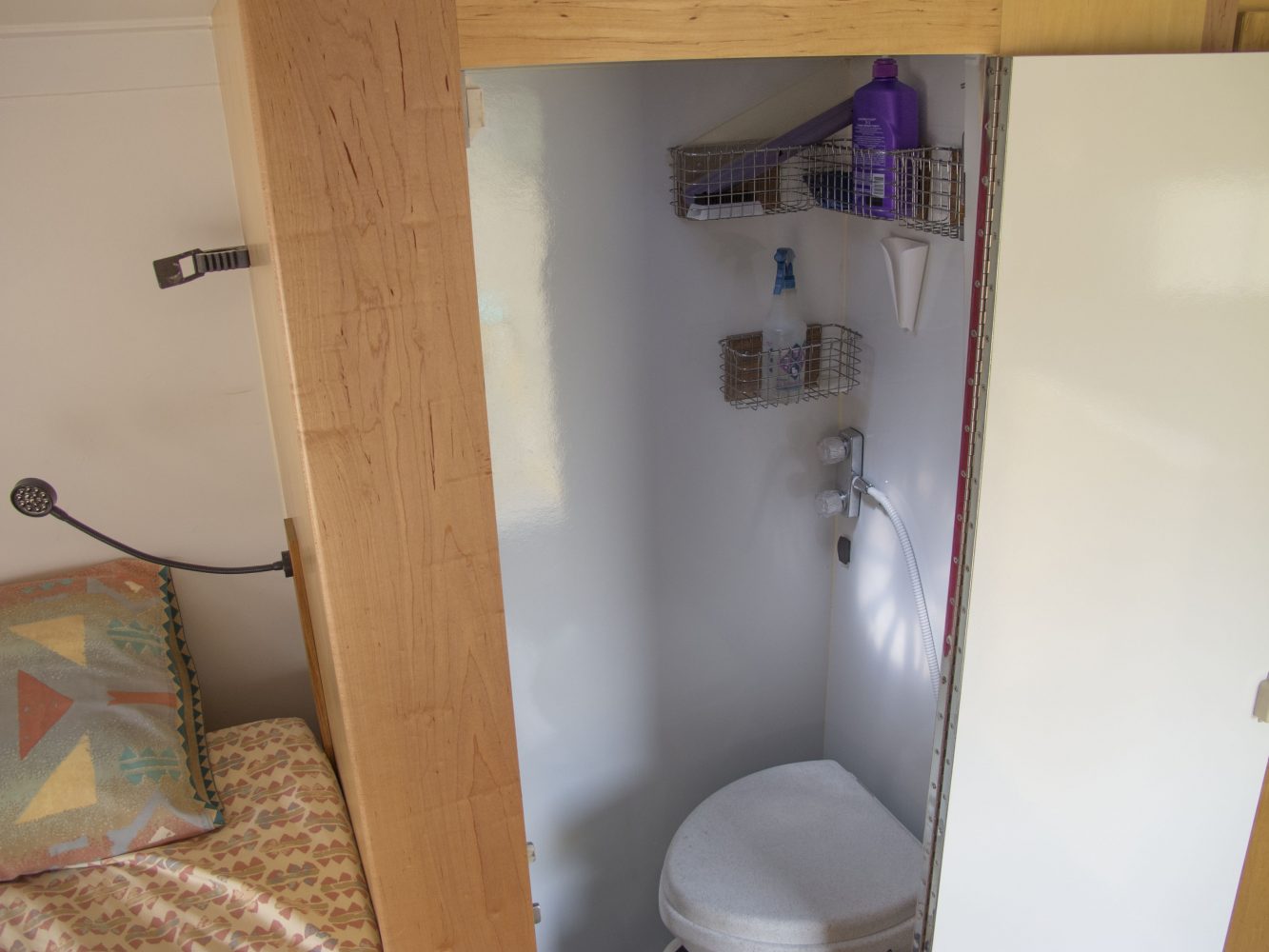 The queen-sized bed is also home-grade (see a theme developing here?), maybe even better, given that the mattress is 8 inches of high-grade natural latex foam. At the bed’s head (streetside end), there’s a nice catchment area for the alarm clock, paperback books, and other items nobody has anymore, or more relevantly, for your smartphone and the charger.
The queen-sized bed is also home-grade (see a theme developing here?), maybe even better, given that the mattress is 8 inches of high-grade natural latex foam. At the bed’s head (streetside end), there’s a nice catchment area for the alarm clock, paperback books, and other items nobody has anymore, or more relevantly, for your smartphone and the charger.
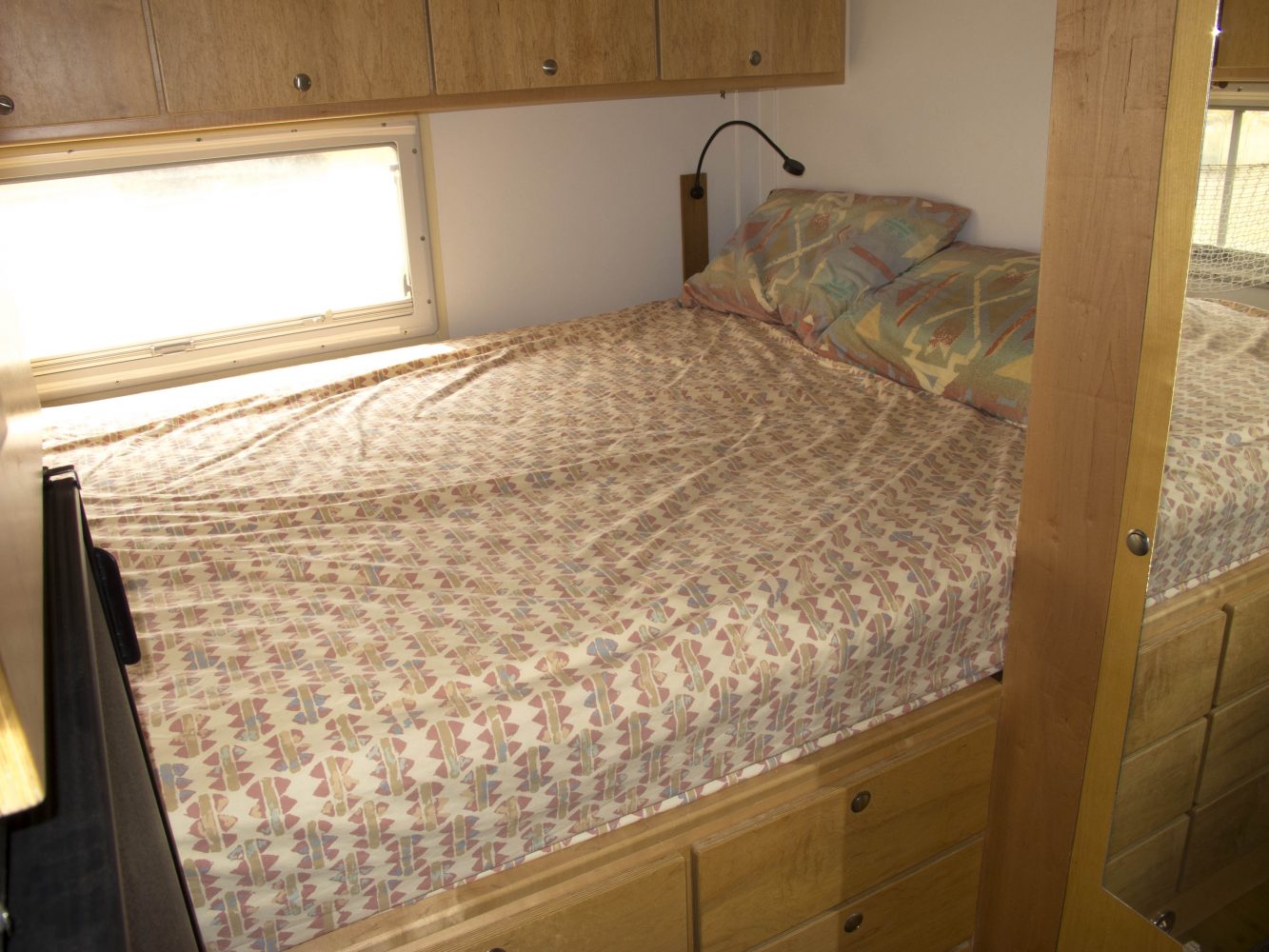 One intentional consequence of the big bed in the back is that it creates an impressive space under the bed that’s accessible from outside or inside. Raise the mattress level high enough and the space becomes vast. In some cabins, as in this Fuso, the space is used for secure dry storage. In others, it provides a “mechanical room” to house the majority of the cabin systems. Frequently, it’s both. But regardless of the use made of the space, it’s generally a most-impressive area.
One intentional consequence of the big bed in the back is that it creates an impressive space under the bed that’s accessible from outside or inside. Raise the mattress level high enough and the space becomes vast. In some cabins, as in this Fuso, the space is used for secure dry storage. In others, it provides a “mechanical room” to house the majority of the cabin systems. Frequently, it’s both. But regardless of the use made of the space, it’s generally a most-impressive area.
And the storage space continues on the inside, with cabinets and drawers all over the place. Big drawers under the bed, big cabinets and drawers at the bow end, and overhead cabinets everywhere. The full complement of resident items—cookware, dishes, books, supplies, spares, etcetera—filled about a fifth of the available space. Everything personal I could think to bring along used up another few percent. I could have left for a month’s worth of solo travel with 60 percent of the storage space still empty.

This impressive storage space is probably the best example of why the giant expo truck is the right tool for going seriously walkabout for a long period of time. It’s “enabling” to have all the supplies and equipment you could want stored safely, yet readily accessible. Add to that enough leftover space for anything special you want to pick up on the way—well, it’s all pretty nice, especially since this truck doesn’t care how much you carry: Beyond the wet weight of the truck, camper and all the systems, John’s Fuso has the ability to carry an extraordinary two-and-a-half additional tons. John’s setup for his Yukon trip shows the substantial amount of volume and organization possible for parts and equipment.

There are a lot of other sweet touches that John has added. A nifty barbeque grill attaches to a fitting at rear streetside and quick-connects to the propane supply, and having an eight-foot Porta-Bote stored along the side is a great add-on, especially since an appropriate outboard stores nicely in a rear compartment. Even slicker is the winch-operated combination motorcycle lift/spare tire carrier that can drop the two spare tires with minimal effort.
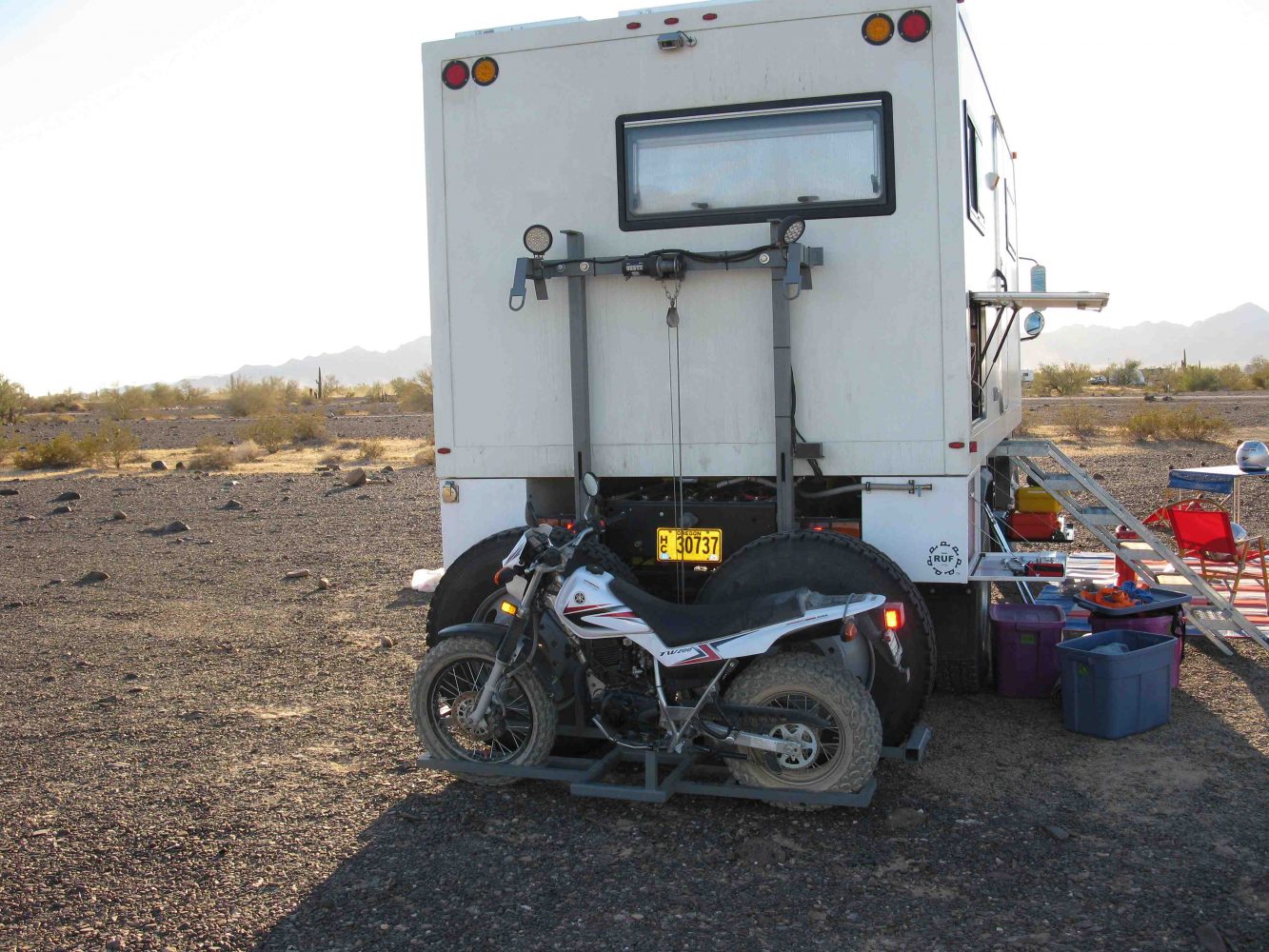 And in keeping with the go-anywhere-for-however-long tenet of the truck, John installed an impressive filtration system that can literally suck up dirty bog slosh and turn it into municipal-quality drinking water.
And in keeping with the go-anywhere-for-however-long tenet of the truck, John installed an impressive filtration system that can literally suck up dirty bog slosh and turn it into municipal-quality drinking water.
 There’s some percentage of the readership that’s read this far mostly so they can righteously conclude, “This ain’t camping.” So let me be the first to admit that they’re right. But it is overlanding. What’s more, it’s overlanding in accommodations that offer the potential for easily and safely taking on a much bigger trek than can be managed out of a Wrangler or Tacoma.
There’s some percentage of the readership that’s read this far mostly so they can righteously conclude, “This ain’t camping.” So let me be the first to admit that they’re right. But it is overlanding. What’s more, it’s overlanding in accommodations that offer the potential for easily and safely taking on a much bigger trek than can be managed out of a Wrangler or Tacoma.
The intersecting area between “vehicles that can travel almost anywhere” and “vehicles you can comfortably live out of for months” is not very large. If you also include “vehicles that one can afford to buy and operate,” the union gets really small.
Costs aside, though, when well-executed, the accommodations and storage of a giant expo truck like John’s 4WD Fuso FM open the prospect of very long trips to remote areas while retaining security and comfort. Should you have the opportunity to own or use one of these special vehicles, I guarantee it’s worth considering their substantial advantages.
